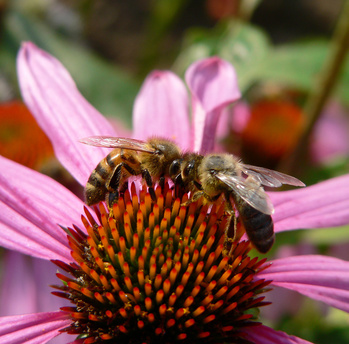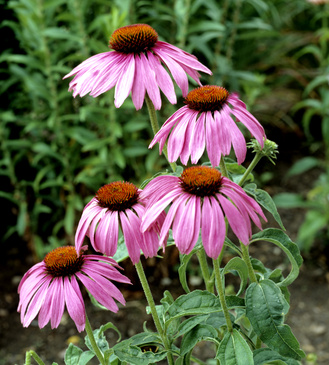Echinacea angustifolia (D.C.) Heller
 Synonyms: Brauneria pallida (Nutt.), B.
angustifolia, purple coneflower, black sampson, Kansas snakeroot, Kansas niggerhead, rudbeckia,
American narrow-leaved coneflower, spider flower
Synonyms: Brauneria pallida (Nutt.), B.
angustifolia, purple coneflower, black sampson, Kansas snakeroot, Kansas niggerhead, rudbeckia,
American narrow-leaved coneflower, spider flower
Order: Compositae
Description: Echinacea is a perennial herb, up to a metre in height, with simple rough stems, hollow near the base and thickening slightly close to the flowerhead. The leaves are elongated, slightly elliptical with entire margins and covered with coarse hairs and protuberances. The purple flower is in the form of a high cone surrounded by rough hairy bracts, downturned purple ray florets and greenish tubular florets. The tapering root is greyish-brown flecked with white. Echinacea is a native of the prairies of the Western USA and is cultivated in Europe.
Parts used: Root and rhizome
Collection: The roots are unearthed in the autumn after flowering. The fresh extract is more effective than the dried root.
Constituents: volatile oil (including humulene and caryophylene), glycoside (echinacoside), polysaccharides, polyacetylenes, isobutylalkamines, echinaceine, phenolics, inulin, betain, resins, sesquiterpene
Actions: immunostimulant, anti-inflammatory, antibacterial, antiviral, vulnerary, antiseptic, peripheral vasodilator, anti-microbial, antibiotic, anti-allergenic, lymphatic tonic, warming alterative, anti-infective, stimulating, inhibits hyaluronidase activity and reduces eosinophil levels
 Indications: boils, septicaemia,
naso-pharyngeal catarrh, pyorrhoea, tonsillitis
Indications: boils, septicaemia,
naso-pharyngeal catarrh, pyorrhoea, tonsillitis
Therapeutics and Pharmacology: Echinacea, having both an antibacterial and antiviral action, is one of the best remedies for helping the body rid itself of microbial infections. It may be used in the treatment of boils, abscesses, carbuncles, septicaemia and other such infections and, combines with other appropriate herbs, it may be used for any infection anywhere in the body. It has been shown to improve the body's resistance to infections such as colds and influenza; it stimulates the lymphatic vascular system and the fibroblasts. It should be taken in small, frequent doses as soon as flu-like symptoms appear. It is of particular value in laryngitis, tonsillitis, and catarrhal conditions of the nose and sinus. The tincture or decoction may be used as a mouthwash in the treatment of pyorrhoea and gingivitis. Echinacea may also be applied as a lotion to infected sores and wounds, and it promotes the healing of old wounds and ulcers. A wash of Echinacea can help relieve the itching of urticaria and this treatment is also useful for stings and bites.
Research has demonstrated that Echinacea stimulates the production of white blood cells to fight infection. The polysaccharide component has an anti-viral action, reducing the ability of pathogens to penetrate tissues. In Germany, echinacein is most often administered intravenously because polysaccharides are rapidly broken down in digestion. Echinacea is of value in the treatment of glandular fever and post-viral fatigue syndrome (myalgic encephalomyelitis), and has most recently been employed in AIDS therapy. There is evidence to show that whole plant preparations are helpful in allergies.
Combinations: Echinacea may be combined with Achillea or Arctostaphylos for cystitis; with Arctium root or Iris for boils; and with Baptisia and Commiphora resin for pharyngitis or tonsillitis.
Caution: High doses can occasionally cause nausea and dizziness.
Preparation and Dosage: (thrice daily)
Regulatory Status: GSL
Dried herb: 1g or by infusion or decoction
Liquid Extract: 1:5 in 45% alcohol: 0.5-1ml
Tincture: 1:5 in 45% alcohol: 1-2ml
Additional Comments: Echinacea was much valued by Native Americans and frontiersmen of the USA as a remedy for snakebite, fevers and for cleansing and healing suppurative wounds. The early settlers adopted the plant as a home remedy for colds and influenza, and it became popular with the 19th century Eclectics. Three species are used medicinally: E angustifolia, E. pallida (Nutt.) and E. purpurea (L.). Scientific research has now confirmed its stimulatory effects on the white blood cells that fight infection, and it is being studied in California as a possible treatment for AIDS.
Bibliography
Bradley, P.R. (ed.) 1992 British Herbal Compendium, Volume 1, BHMA, Bournemouth.
BHMA 1983 British Herbal Pharmacopoeia, BHMA, Bournemouth.
Grieve, M. 1931 A Modern Herbal, (ed. C.F. Leyel 1985), London.
Hoffmann, D. 1990 The New Holistic Herbal, Second Edition, Element, Shaftesbury.
Lust, J. 1990 The Herb Book, Bantam, London.
Mabey, R. (ed.) 1991 The Complete New Herbal, Penguin, London.
Mills, S.Y. 1993 The Essential Book of Herbal Medicine, Penguin, London (First published in 1991 as Out of the Earth, Arkana)
Mills, S.Y. 1993 The A-Z of Modern Herbalism, Diamond Books, London.
Moore, M. 1989 Medicinal Plants of the Desert and Canyon West, Museum of New Mexico Press, Santa Fe.
Ody, P. 1993 The Herb Society's Complete Medicinal Herbal, Dorling Kindersley, London.
Polunin, M. and Robbins, C. 1992 The Natural Pharmacy, Dorling Kindersley, London.
Weiss, R.F. 1991 Herbal Medicine, Beaconsfield Arcanum, Beaconsfield.
Wren, R.C. 1988 Potter's New Cyclopaedia of Botanical Drugs and Preparations, C.W.Daniel, Saffron Walden.










